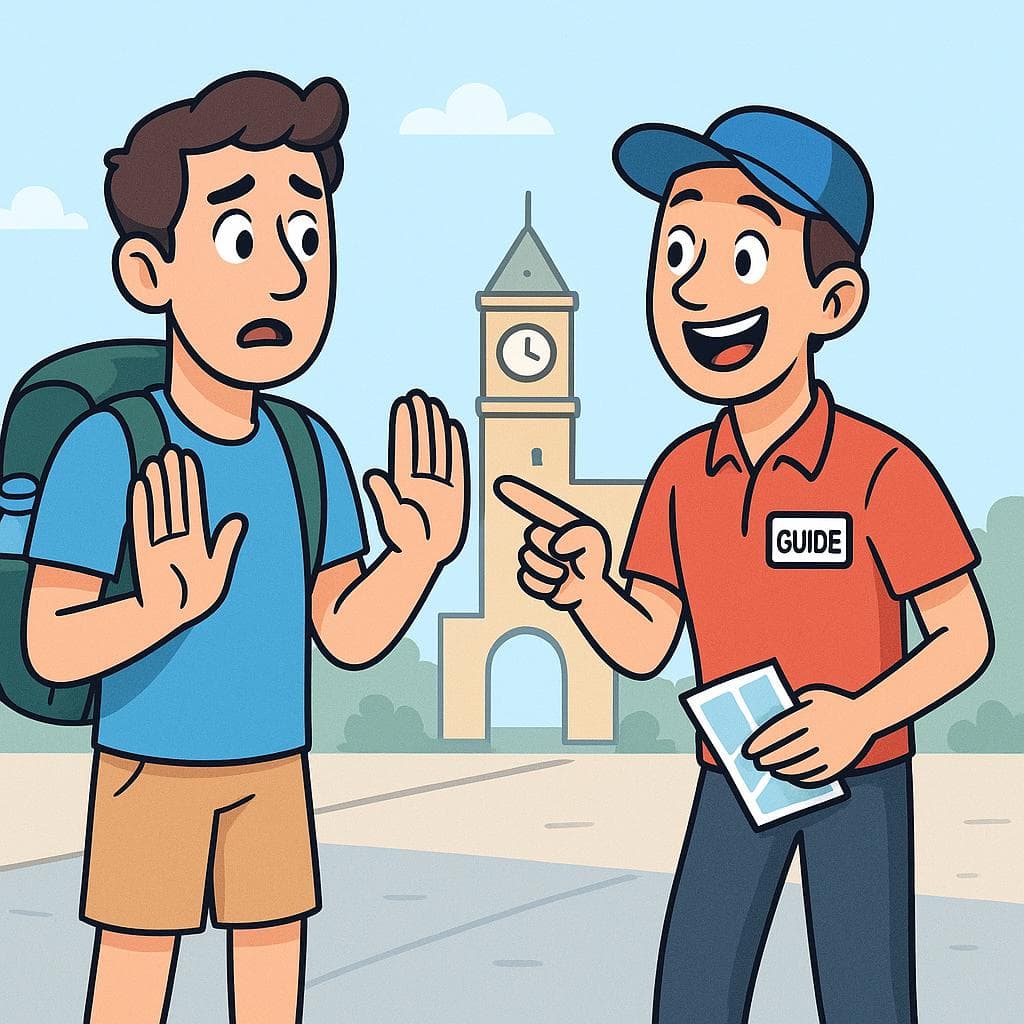Please speak more slowly
in SpanishPor favor, hable más despacio.
/por fah-VOR, AH-bleh mahs des-PAH-see-oh/
This is the most standard and polite way to ask someone to speak more slowly. Use it with strangers, elders, or in any formal setting.

Don't be shy! Asking someone to 'hablar más despacio' is a normal and necessary part of learning Spanish.
💬Other Ways to Say It
Por favor, habla más despacio.
/por fah-VOR, AH-blah mahs des-PAH-see-oh/
This is the informal version of the primary phrase. The verb 'habla' is used when you're talking to someone you know well, someone your age, or a child.
¿Puede hablar más despacio, por favor?
/PWEH-deh ah-BLAR mahs des-PAH-see-oh, por fah-VOR/
Phrasing it as a question ('Can you speak...?') makes the request sound a little softer and even more polite. This is an excellent, safe choice for almost any formal situation.
¿Puedes hablar más despacio, por favor?
/PWEH-des ah-BLAR mahs des-PAH-see-oh, por fah-VOR/
This is the informal question version, using 'puedes' for 'tú'. It's a very common and friendly way to make the request among peers.
Más despacio, por favor.
/mahs des-PAH-see-oh, por fah-VOR/
A more direct, concise way to ask. It's not rude, especially with 'por favor', but it's less cushioned than the full sentence versions.
Un poco más despacio, por favor.
/oon POH-koh mahs des-PAH-see-oh, por fah-VOR/
Adding 'un poco' (a little) softens the request significantly. It implies they only need to slow down a small amount, which can feel more polite.
Perdón, ¿podría hablar más despacio?
/per-DON, poh-DREE-ah ah-BLAR mahs des-PAH-see-oh/
This is one of the most polite and deferential ways to ask. 'Podría' is a conditional form that's like saying 'Could you possibly...?' in English. Starting with 'Perdón' (Excuse me) adds another layer of politeness.
Más lento, por favor.
/mahs LEN-toh, por fah-VOR/
'Lento' means 'slow'. While 'despacio' is more common for the action of speaking, 'lento' is perfectly understandable and used often, especially in casual contexts. It's slightly more direct.
🔑Key Words
Key Words to learn:
📊Quick Comparison
Here’s a quick guide to choosing the right phrase based on who you're talking to.
| Phrase | Formality | Best For | Avoid When |
|---|---|---|---|
| Hable más despacio, por favor. | Formal | Speaking to strangers, elders, officials, or anyone you'd address as 'usted'. | Chatting with close friends or children, where it might sound too stiff. |
| Habla más despacio, por favor. | Informal | Friends, family, and people your own age that you know. | Formal situations like a business meeting, a doctor's appointment, or talking to a police officer. |
| ¿Puede hablar más despacio? | Formal | A slightly softer and more polite way to ask in formal situations. | You need to be very quick and direct. |
| Más despacio, por favor. | Neutral | Quick, direct communication when you don't have time for a full sentence. | You want to be exceptionally polite or deferential. |
📈Difficulty Level
Generally easy. The main challenge is the 'c' in 'despacio', which is an 's' sound in Latin America but a 'th' sound in most of Spain. The rhythm of 'más-des-PA-cio' is also key.
The only grammatical hurdle is remembering to use the formal 'hable' (for usted) versus the informal 'habla' (for tú). This is a fundamental concept in Spanish.
Fairly straightforward. The main nuance is knowing how and when to add extra words like 'perdón' or 'un poco' to make the request even more polite.
Key Challenges:
- Choosing between the formal 'hable' and informal 'habla'.
- Pronouncing 'despacio' with a natural rhythm.
💡Examples in Action
Disculpe, señor. Soy turista y mi español no es muy bueno. ¿Puede hablar más despacio, por favor?
Excuse me, sir. I'm a tourist and my Spanish isn't very good. Can you speak more slowly, please?
¡Espera, espera! Habla más despacio, por favor. No me quiero perder ningún detalle del chisme.
Wait, wait! Speak more slowly, please. I don't want to miss any details of the gossip.
Profesora, perdón por interrumpir. ¿Podría explicar esa parte un poco más despacio? No la entendí bien.
Professor, sorry to interrupt. Could you explain that part a little more slowly? I didn't understand it well.
Un momento, John. Hable más despacio, por favor. La conexión es mala y se corta un poco.
One moment, John. Please speak more slowly. The connection is bad and it's cutting out a bit.
🌍Cultural Context
It's Not Rude to Ask!
In Spanish-speaking cultures, people are generally very warm and patient with language learners. Asking someone to slow down is completely normal and is almost never seen as rude, especially when you say 'por favor'. They'll appreciate that you're trying to understand and will be happy to help.
The Power of 'Por Favor'
The phrase 'por favor' (please) is your magic wand for politeness in Spanish. A request like 'Más despacio' can sound like a command without it. Adding 'por favor' instantly transforms it into a polite request.
Explain Your Situation
To make your request even friendlier, you can give a quick reason. Saying something like 'Perdón, estoy aprendiendo español' (Sorry, I'm learning Spanish) before you ask them to slow down creates an instant connection and makes people even more willing to help.
❌ Common Pitfalls
Formal vs. Informal Mix-up
Mistake: "Using the informal 'habla' with a police officer, an elderly person, or a new boss. For example: 'Señor, habla más despacio.'"
Correction: 'Señor, hable más despacio, por favor.'
Using 'Lento' Instead of 'Despacio'
Mistake: "'Por favor, hable más lento.'"
Correction: 'Por favor, hable más despacio.'
Forgetting 'Por Favor'
Mistake: "Walking up to someone and just saying 'Hable más despacio.'"
Correction: 'Disculpe, ¿puede hablar más despacio, por favor?'
💡Pro Tips
Pair it with an Apology
To be extra polite, start your request with 'Perdón' or 'Disculpe' (both mean 'excuse me'). This acknowledges that you're interrupting them and softens the request. For example: 'Perdón, ¿puede hablar más despacio?'
Use Non-Verbal Cues
Don't underestimate body language. As you say the phrase, you can use a hand gesture to signal 'slow down' (like moving your hand up and down slowly) or have a slightly puzzled look on your face. This helps communicate your meaning even before they've processed all the words.
Combine it with 'No entiendo'
A very effective and natural combination is to first state the problem, then ask for the solution. 'No entiendo. ¿Puedes hablar más despacio, por favor?' (I don't understand. Can you speak more slowly, please?). This gives them context for your request.
🗺️Regional Variations
Spain
The 'ceceo' or 'distinción' (pronouncing 'c' before i/e and 'z' as 'th') is the most noticeable difference. Use of 'tú' is very common among peers.
Mexico
Mexicans often use the formal 'usted' ('puede') more frequently than in Spain, even in semi-formal settings, as a sign of general respect. It's a safe bet to use the formal version.
Argentina & Uruguay
The defining feature is the use of 'vos' instead of 'tú'. This changes the verb: 'puedes' becomes 'podés' and 'habla' becomes 'hablá' (with the stress on the last 'a').
Caribbean (Cuba, Puerto Rico, Dominican Republic)
This is a region where you will definitely need this phrase! The rapid pace and dropped consonants can be very challenging for learners. The request will be met with understanding.
💬What Comes Next?
After you ask them to slow down
¡Claro que sí! / ¡Por supuesto!
Of course! / Absolutely!
Gracias.
Thank you.
They slow down and check with you
¿Así está mejor?
Is this better?
Sí, perfecto. ¡Muchas gracias!
Yes, perfect. Thank you very much!
They apologize for speaking fast
Ah, perdón. A veces hablo muy rápido.
Oh, sorry. Sometimes I speak very fast.
No hay problema. Todavía estoy aprendiendo.
No problem. I'm still learning.
🧠Memory Tricks
This cultural touchstone is a perfect memory hook. Every time you hear 'despacio', your brain can connect it to the slow, rhythmic beat of the song.
🎬In Popular Culture
Despacito
by Luis Fonsi ft. Daddy Yankee
The song uses the word to describe a slow, romantic encounter.
Why it matters: This song is a fantastic mnemonic device. It permanently linked the sound and meaning of 'despacito' (very slowly) in the minds of millions of people worldwide, making it one of the most recognizable Spanish words.
📺 Popular on Spotify, YouTube, and all major music platforms.
🎯Your Learning Path
➡️ Learn Next:
I don't understand.
This is the most common reason you'd ask someone to slow down. It's the perfect preceding phrase.
Can you repeat that, please?
If slowing down isn't enough, asking them to repeat the phrase is the next logical step.
What does ... mean?
After they slow down or repeat something, you can use this to ask about a specific word you don't know.
How do you say... in Spanish?
This flips the script, allowing you to ask for the words you need to express yourself.
✏️Test Your Knowledge
💡 Quick Quiz: Please speak more slowly
Question 1 of 3
You are at a formal conference and need to ask the presenter a question, but she is speaking very fast. What is the most appropriate way to ask her to slow down?
Frequently Asked Questions
What's the real difference between 'hable más despacio' and 'habla más despacio'?
It's all about formality. Use 'hable' (with an 'e') when speaking to someone you should show respect to, like an elder, a boss, a professor, or a stranger. This is the 'usted' form. Use 'habla' (with an 'a') for friends, family, or people your age. This is the 'tú' form. When in doubt, using the formal 'hable' is always the safer, more polite option.
Is it rude to ask a native speaker to slow down?
Absolutely not! It's a completely normal part of communication for language learners. Most native speakers are very happy to slow down because it shows you are genuinely trying to understand them. As long as you add 'por favor', your request will be received positively.
What if I ask them to slow down and they still speak too fast?
This happens! You can politely ask again, perhaps saying, 'Perdón, todavía un poco más despacio, por favor' (Sorry, still a little more slowly, please). You can also try to ask them to repeat a specific part by saying, '¿Puede repetir la última frase?' (Can you repeat the last sentence?).
Is 'Más lento, por favor' correct?
Yes, it's correct and everyone will understand you. However, 'más despacio' is generally considered more natural when talking about the speed of an action like speaking. Think of 'despacio' as 'slowly' (an adverb) and 'lento' as 'slow' (an adjective). You do an action 'despacio'.
How can I make my request sound as polite as possible?
To be extra polite, combine a few elements. Start with an apology like 'Disculpe' or 'Perdón'. Phrase it as a question using the conditional 'podría'. And of course, end with 'por favor'. The ultimate polite version is: 'Disculpe, ¿podría hablar un poco más despacio, por favor?'
I know the song 'Despacito'. Does that just mean 'slowly'?
Almost! 'Despacito' is the diminutive form of 'despacio'. The '-ito' ending adds a sense of 'little' or 'nicely'. So while 'despacio' means 'slowly', 'despacito' means something like 'nice and slowly' or 'very slowly'. It's a more affectionate and gentle way to say it.
📚Continue Learning Spanish Phrases
Explore More Phrases in These Categories
Find similar phrases to expand your Spanish vocabulary:
Want to Learn More Spanish Phrases?
Browse our complete collection of Spanish phrases organized by situation, from basic greetings to advanced conversations. Perfect for travelers, students, and anyone learning Spanish.
View All Spanish Phrases →


